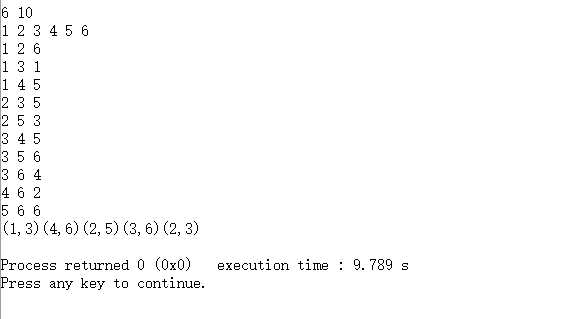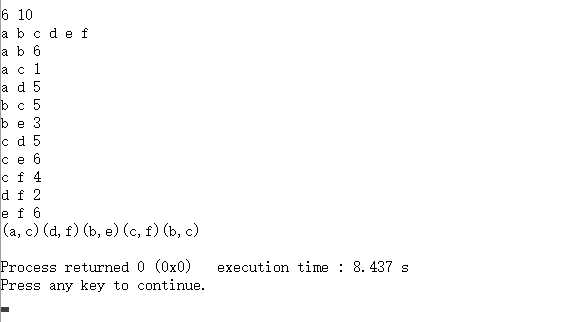最小生成树—— Kruskal算法
Posted
tags:
篇首语:本文由小常识网(cha138.com)小编为大家整理,主要介绍了最小生成树—— Kruskal算法相关的知识,希望对你有一定的参考价值。
【由于时间不是很充足,现将完整代码放出,具体分析和思路,以后再更新】
【详细代码】经codeblocks-13.12调试
1 #include<iostream> 2 #include<stdio.h> 3 #define MAX_ARC 1001 //边的最大权值 4 #define MAX_LINE 401 //图的最大边数 5 #define MAX_NUM 21 //图的最大顶点数 6 #define ERROR 0 7 #define OK 1 8 using namespace std; 9 10 typedef int VertexType; 11 12 typedef struct Edges{ 13 VertexType head; 14 VertexType tail; 15 int weight; 16 }Edges; 17 18 typedef struct MGraph 19 { 20 VertexType vexs[MAX_NUM]; 21 Edges edges[MAX_LINE]; 22 int vexnum; 23 int arcnum; 24 }MGraph; 25 26 int Find(int *parent,int f)//判断是否回路 27 { 28 while(parent[f]>0) 29 { 30 f=parent[f]; 31 } 32 return f; 33 } 34 35 int LocateVertex(MGraph G,VertexType u)//根据顶点返回序号,主要用于顶点是字符的情况 36 { 37 int i; 38 for(i=1;i<=G.vexnum;i++) 39 { 40 if(u==G.vexs[i]) 41 { 42 return i; 43 } 44 } 45 return ERROR; 46 } 47 48 void MiniSpanTree_Kruskal(MGraph G) 49 { 50 int parent[MAX_NUM];//判断边与边是否形成环路的辅助数组 51 int i,n,m; 52 53 for(i=1;i<=G.vexnum;i++)//初始化辅助数组 54 { 55 parent[i]=0; 56 } 57 for(i=1;i<=G.arcnum;i++)//循环每一条边 58 { 59 n=Find(parent,LocateVertex(G,G.edges[i].head)); 60 m=Find(parent,LocateVertex(G,G.edges[i].tail)); 61 62 if(n!=m)//不等说明没有形成环路,具体原因,可以自己画个图 63 { 64 parent[n]=m; 65 cout<<"("<<G.edges[i].head<<","<<G.edges[i].tail<<")"; 66 } 67 } 68 cout<<endl; 69 } 70 71 int main() 72 { 73 MGraph G; 74 cin>>G.vexnum>>G.arcnum;//输入总顶点书和总边数 75 76 int i; 77 78 for(i=1;i<=G.vexnum;i++)//输入顶点 79 { 80 cin>>G.vexs[i]; 81 } 82 83 for(i=1;i<=G.arcnum;i++)//输入边(包含头,尾,权值) 84 { 85 cin>>G.edges[i].head>>G.edges[i].tail>>G.edges[i].weight; 86 } 87 88 //将edges按升序排序 89 VertexType temp1; 90 int temp2,j; 91 for(i=1;i<=G.arcnum;i++) 92 { 93 for(j=1;j<=G.arcnum-i;j++) 94 { 95 if(G.edges[j].weight>G.edges[j+1].weight) 96 { 97 temp1=G.edges[j].head; 98 G.edges[j].head=G.edges[j+1].head; 99 G.edges[j+1].head=temp1; 100 101 temp1=G.edges[j].tail; 102 G.edges[j].tail=G.edges[j+1].tail; 103 G.edges[j+1].tail=temp1; 104 105 temp2=G.edges[j].weight; 106 G.edges[j].weight=G.edges[j+1].weight; 107 G.edges[j+1].weight=temp2; 108 } 109 } 110 } 111 112 MiniSpanTree_Kruskal(G); 113 return 0; 114 }
【运行结果】不同VertexType


【后记】
算法思想提高智商,算法实现积累经验
以上是关于最小生成树—— Kruskal算法的主要内容,如果未能解决你的问题,请参考以下文章